light MITSUBISHI SHOGUN 2008 (in English) Owner's Guide
[x] Cancel search | Manufacturer: MITSUBISHI, Model Year: 2008, Model line: SHOGUN, Model: MITSUBISHI SHOGUN 2008Pages: 538, PDF Size: 25.09 MB
Page 208 of 538
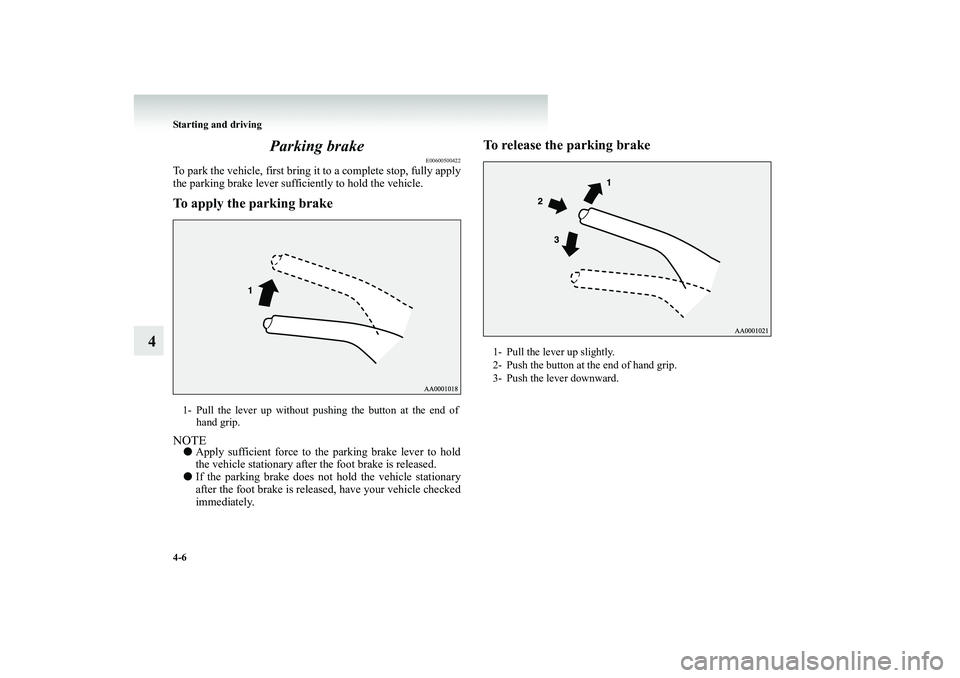
4-6 Starting and driving
4
Parking brake
E00600500422
To park the vehicle, first bring it to a complete stop, fully apply the parking brake lever sufficiently to hold the vehicle.To apply the parking brakeNOTE●
Apply sufficient force to the parking brake lever to hold the vehicle stationary after
the foot brake is released.
●
If the parking brake does not hold the vehicle stationary after the foot brake is releas
ed, have your vehicle checked
immediately.
To release the parking brake
1- Pull the lever up without pushing the button at the end of
hand grip.
1- Pull the lever up slightly. 2- Push the button at the end of hand grip. 3- Push the lever downward.
BK-BK2008E1ENUK.en-uk-Section7.fm Page 6 Wednesday, January 9, 2008 4:36 PM
Page 216 of 538

4-14 Starting and driving
4
Automatic extension of mirrorsIf the engine is stopped and st
arted with the mirrors retracted,
the mirrors automatically extend
for safety when the vehicle
speed reaches 30 km/h (19 mph).Heated mirror*
E00601200312
To demist or defrost the outside rear-view mirrors, press the rear window demister switch. The indication lamp (C) will illuminate while the demister is on.The heater will be turned off automatically in about 20 minutes.
Ignition switch
E00601400822
LOCKThe engine is stopped and the steering wheel locked. The keycan only be inserted and removed in this position.ACCThe engine is stopped, but the
electrical devices such as the
radio and cigarette lighter can be operated.ONThe engine is running, and al
l the vehicle’s electrical devices
can be operated.STARTThe starter motor operates. After
the engine has started, release
the key and it will automatically return to the “ON” position.Vehicles with M/T Vehicles with A/T
BK-BK2008E1ENUK.en-uk-Section7.fm Page
14 Wednesday, January 9, 2008 4:36 PM
Page 220 of 538
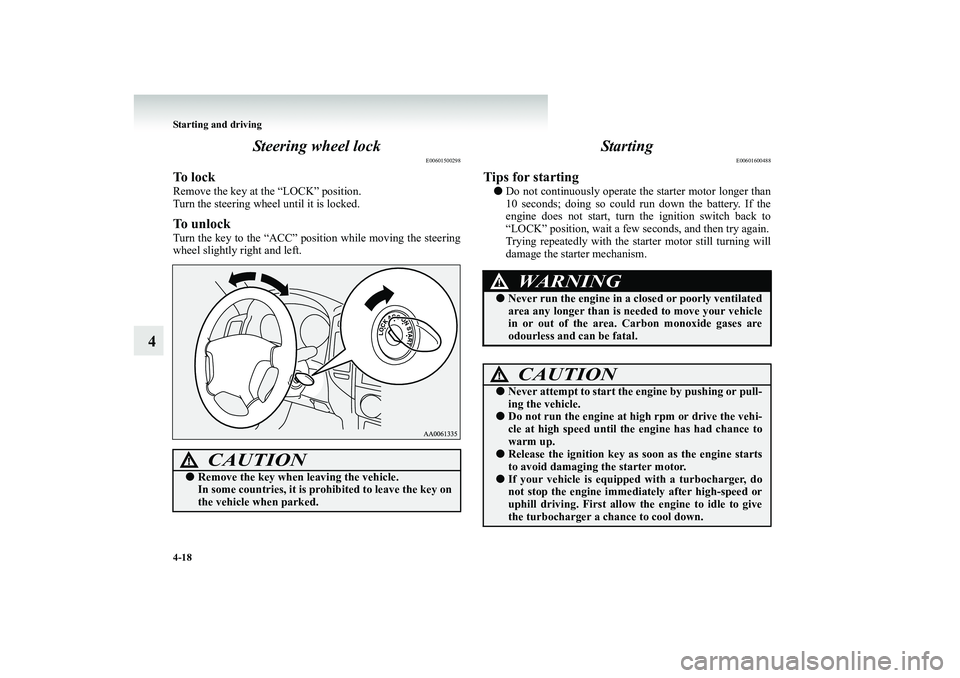
4-18 Starting and driving
4
Steering wheel lock
E00601500298
To l o c kRemove the key at the “LOCK” position. Turn the steering wheel until it is locked.To unlockTurn the key to the “ACC” position while moving the steering wheel slightly right and left.
Starting
E00601600488
Tips for starting●
Do not continuously operate the starter motor longer than 10 seconds; doing so could run down the battery. If the engine does not start, turn the ignition switch back to“LOCK” position, wait a few seconds, and then try again. Trying repeatedly with the starter motor still turning will damage the starter mechanism.
CAUTION
!●
Remove the key when leaving the vehicle. In some countries, it is pr
ohibited to leave the key on
the vehicle when parked.
WARNING
!●
Never run the engine in a cl
osed or poorly ventilated
area any longer than is needed to move your vehiclein or out of the area. Carbon monoxide gases are odourless and can be fatal.CAUTION
!●
Never attempt to start the engine by pushing or pull- ing the vehicle.
●
Do not run the engine at hi
gh rpm or drive the vehi-
cle at high speed until th
e engine has had chance to
warm up.
●
Release the ignition key as
soon as the engine starts
to avoid damaging the starter motor.
●
If your vehicle is equipp
ed with a turbocharger, do
not stop the engine immedi
ately after high-speed or
uphill driving. First allow the engine to idle to give the turbocharger a chance to cool down.
BK-BK2008E1ENUK.en-uk-Section7.fm Page
18 Wednesday, January 9, 2008 4:36 PM
Page 223 of 538
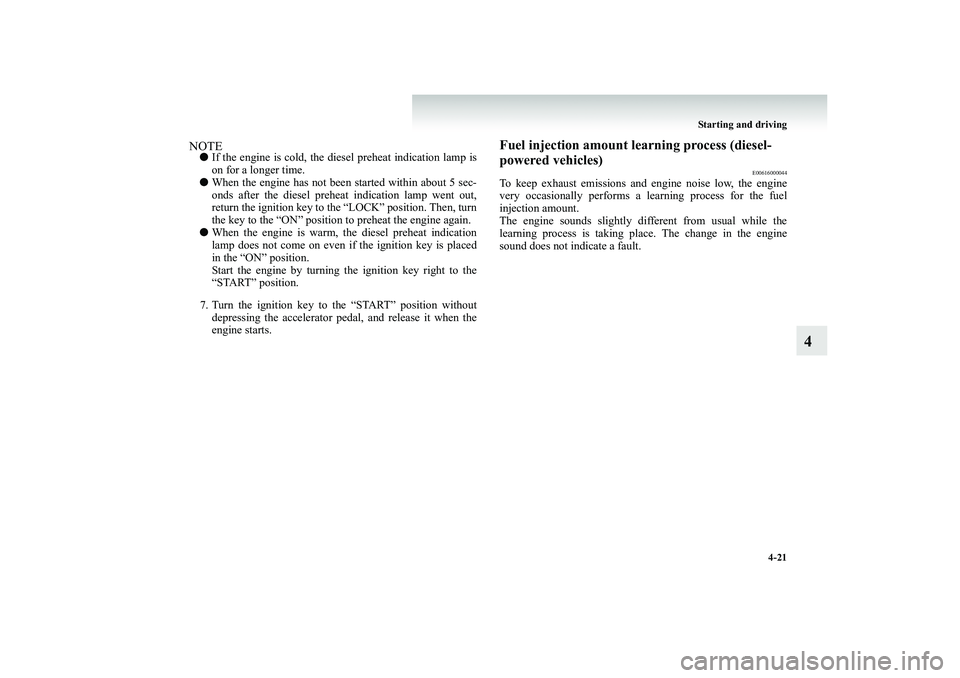
Starting and driving
4-21
4
NOTE●
If the engine is cold, the di
esel preheat indication lamp is
on for a longer time.
●
When the engine has not been
started within about 5 sec-
onds after the diesel preheat
indication lamp went out,
return the ignition key to the “LOCK” position. Then, turn the key to the “ON” position to preheat the engine again.
●
When the engine is warm, th
e diesel preheat indication
lamp does not come on even
if the ignition key is placed
in the “ON” position. Start the engine by turning the ignition key right to the“START” position.
7. Turn the ignition key to the “START” position without
depressing the acceler
ator pedal, and release it when the
engine starts.
Fuel injection amount learning process (diesel- powered vehicles)
E00616000044
To keep exhaust emissions and engine noise low, the engine very occasionally performs a
learning process for the fuel
injection amount. The engine sounds slightly di
fferent from usual while the
learning process is taking pl
ace. The change in the engine
sound does not indicate a fault.
BK-BK2008E1ENUK.en-uk-Section7.fm Page
21 Wednesday, January 9, 2008 4:36 PM
Page 252 of 538
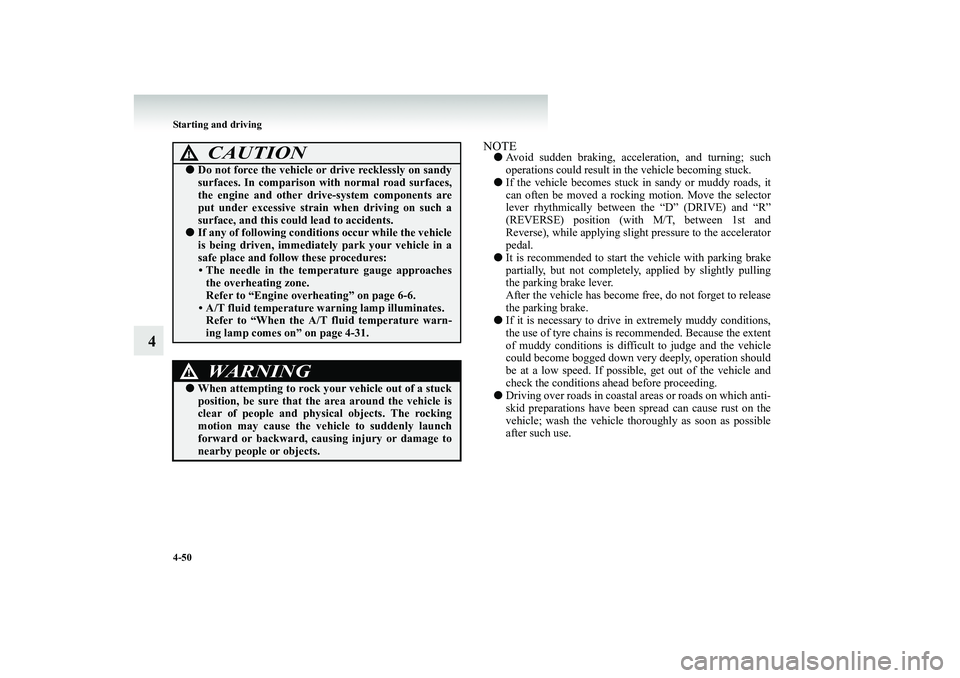
4-50 Starting and driving
4
NOTE●
Avoid sudden braking, acceler
ation, and turning; such
operations could result in the vehicle becoming stuck.
●
If the vehicle becomes stuck in sandy or muddy roads, it can often be moved a rocking motion. Move the selectorlever rhythmically between
the “D” (DRIVE) and “R”
(REVERSE) position (with M/T, between 1st and Reverse), while applying sli
ght pressure to the accelerator
pedal.
●
It is recommended to start th
e vehicle with parking brake
partially, but not completely, applied by slightly pullingthe parking brake lever. After the vehicle has become fr
ee, do not forget to release
the parking brake.
●
If it is necessary to drive in extremely muddy conditions, the use of tyre chains is recommended. Because the extent of muddy conditions is difficult to judge and the vehiclecould become bogged down very deeply, operation should be at a low speed. If possible
, get out of the vehicle and
check the conditions ah
ead before proceeding.
●
Driving over roads in coastal
areas or roads on which anti-
skid preparations have been
spread can cause rust on the
vehicle; wash the vehicle thoroughly as soon as possibleafter such use.
CAUTION
!●
Do not force the vehicle or drive recklessly on sandy surfaces. In comparison wi
th normal road surfaces,
the engine and other driv
e-system components are
put under excessive strain
when driving on such a
surface, and this coul
d lead to accidents.
●
If any of following conditions occur while the vehicle is being driven, immediatel
y park your vehicle in a
safe place and follow these procedures:• The needle in the temp
erature gauge approaches
the overheating zone. Refer to “Engine overheating” on page 6-6. • A/T fluid temperature warning lamp illuminates. Refer to “When the A/T fluid temperature warn-ing lamp comes on” on page 4-31.WARNING
!●
When attempting to rock your vehicle out of a stuck position, be sure that the area around the vehicle is clear of people and physic
al objects. The rocking
motion may cause the vehicle to suddenly launch forward or backward, caus
ing injury or damage to
nearby people or objects.
BK-BK2008E1ENUK.en-uk-Section7.fm Page
50 Wednesday, January 9, 2008 4:36 PM
Page 253 of 538
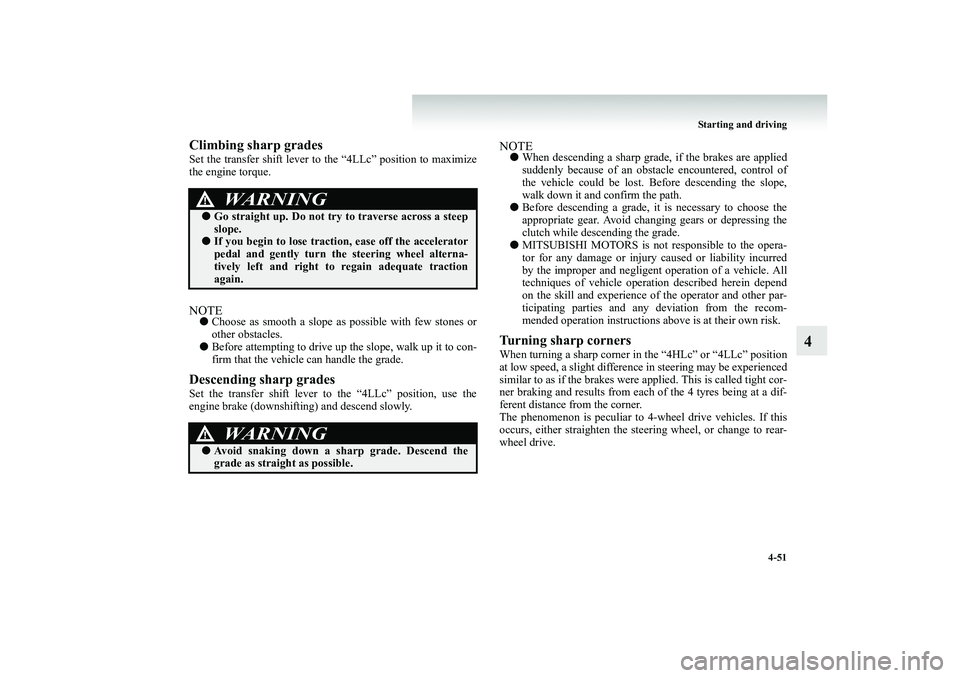
Starting and driving
4-51
4
Climbing sharp gradesSet the transfer shift lever to
the “4LLc” position to maximize
the engine torque.NOTE●
Choose as smooth a slope as possible with few stones or other obstacles.
●
Before attempting to drive up the slope, walk up it to con- firm that the vehicle can handle the grade.
Descending sharp gradesSet the transfer shift lever to the “4LLc” position, use the engine brake (downshifting) and descend slowly.
NOTE●
When descending a sharp grade,
if the brakes are applied
suddenly because of an obstacle encountered, control of the vehicle could be lost. Before descending the slope, walk down it and confirm the path.
●
Before descending a grade, it is necessary to choose the appropriate gear. Avoid changi
ng gears or depressing the
clutch while descending the grade.
●
MITSUBISHI MOTORS is not responsible to the opera- tor for any damage or injury caused or liability incurred by the improper and negligent operation of a vehicle. Alltechniques of vehicle operation described herein depend on the skill and experience of the operator and other par- ticipating parties and any deviation from the recom-mended operation instructions above is at their own risk.
Turning sharp cornersWhen turning a sharp corner in
the “4HLc” or “4LLc” position
at low speed, a slight differen
ce in steering may be experienced
similar to as if the brakes were applied. This is called tight cor-ner braking and results from each of the 4 tyres being at a dif- ferent distance fr
om the corner.
The phenomenon is peculiar to 4-wheel drive vehicles. If thisoccurs, either straighten the st
eering wheel, or change to rear-
wheel drive.
WARNING
!●
Go straight up. Do not try to traverse across a steep slope.
●
If you begin to lose traction, ease off the accelerator pedal and gently turn th
e steering wheel alterna-
tively left and right to regain adequate tractionagain.WARNING
!●
Avoid snaking down a sharp grade. Descend the grade as straight as possible.
BK-BK2008E1ENUK.en-uk-Section7.fm Page
51 Wednesday, January 9, 2008 4:36 PM
Page 254 of 538
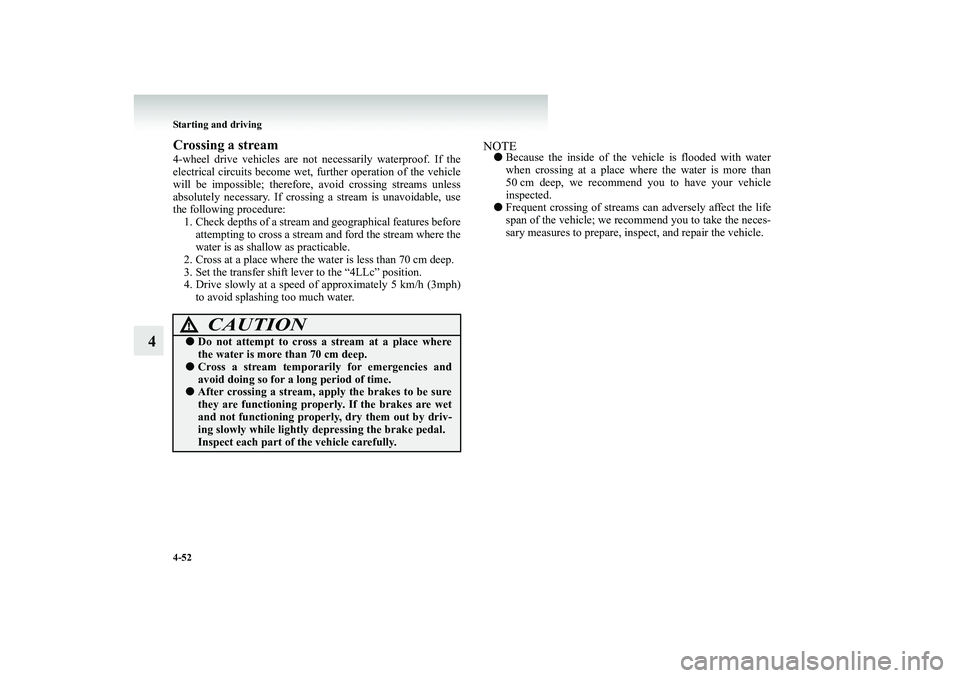
4-52 Starting and driving
4
Crossing a stream4-wheel drive vehicles are not
necessarily waterproof. If the
electrical circuits become wet,
further operation
of the vehicle
will be impossible; therefore,
avoid crossing streams unless
absolutely necessary. If crossi
ng a stream is unavoidable, use
the following procedure:1. Check depths of a stream a
nd geographical features before
attempting to cross a stream
and ford the stream where the
water is as shallow as practicable.
2. Cross at a place where the water is less than 70 cm deep. 3. Set the transfer shift lever to the “4LLc” position. 4. Drive slowly at a speed of
approximately 5 km/h (3mph)
to avoid splashing too much water.
NOTE●
Because the inside of the ve
hicle is flooded with water
when crossing at a place wh
ere the water is more than
50 cm deep, we recommend you to have your vehicle inspected.
●
Frequent crossing of streams
can adversely affect the life
span of the vehicle; we recommend you to take the neces- sary measures to prepare, in
spect, and repair the vehicle.
CAUTION
!●
Do not attempt to cross a stream at a place where the water is more than 70 cm deep.
●
Cross a stream temporar
ily for emergencies and
avoid doing so for a long period of time.
●
After crossing a stream, apply the brakes to be sure they are functioning properl
y. If the brakes are wet
and not functioning properly, dry them out by driv-ing slowly while lightly de
pressing the brake pedal.
Inspect each part of
the vehicle carefully.
BK-BK2008E1ENUK.en-uk-Section7.fm Page
52 Wednesday, January 9, 2008 4:36 PM
Page 255 of 538
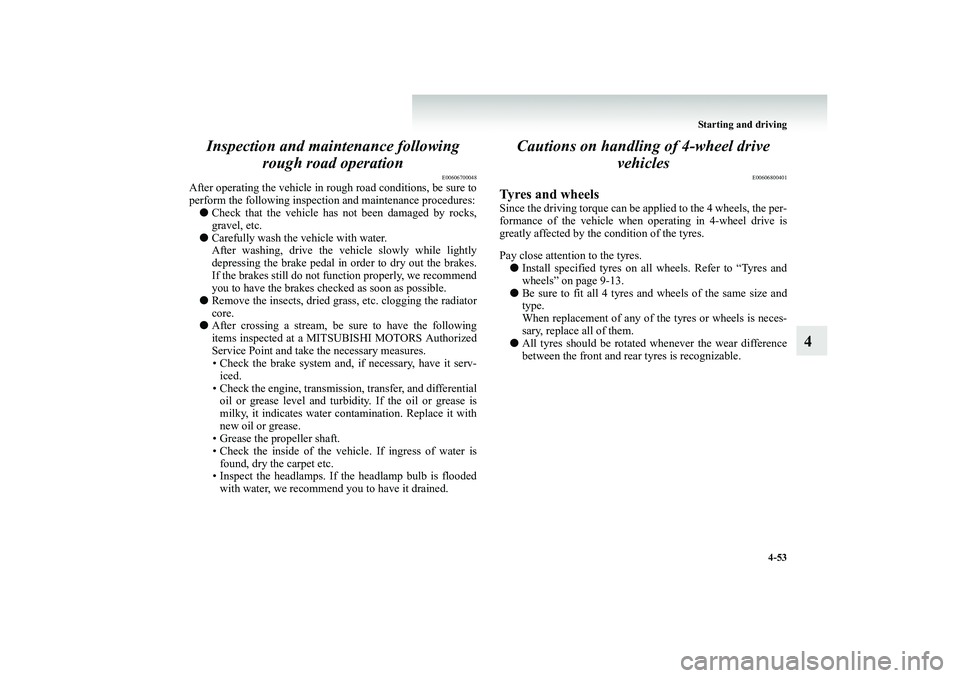
Starting and driving
4-53
4
Inspection and main
tenance following
rough road operation
E00606700048
After operating the vehicle in rough road conditions, be sure to perform the following inspection and maintenance procedures: ●
Check that the vehicle has not been damaged by rocks, gravel, etc.
●
Carefully wash the vehicle with water. After washing, drive the vehicle slowly while lightlydepressing the brake pedal in order to dry out the brakes. If the brakes still do not function properly, we recommend you to have the brakes checked as soon as possible.
●
Remove the insects, dried grass, etc. clogging the radiator core.
●
After crossing a stream, be sure to have the following items inspected at a MITS
UBISHI MOTORS Authorized
Service Point and take the necessary measures. • Check the brake system and,
if necessary, have it serv-
iced. • Check the engine, transmissi
on, transfer, and differential
oil or grease level and turbid
ity. If the oil or grease is
milky, it indicates water co
ntamination. Replace it with
new oil or grease. • Grease the propeller shaft.• Check the inside of the vehi
cle. If ingress of water is
found, dry the carpet etc. • Inspect the headlamps. If th
e headlamp bulb is flooded
with water, we recommend you to have it drained.
Cautions on handling
of 4-wheel drive
vehicles
E00606800401
Tyres and wheelsSince the driving torque can be
applied to the 4 wheels, the per-
formance of the vehicle when
operating in 4-wheel drive is
greatly affected by th
e condition of the tyres.
Pay close attention to the tyres. ●
Install specified tyres on all
wheels. Refer to “Tyres and
wheels” on page 9-13.
●
Be sure to fit all 4 tyres an
d wheels of the same size and
type. When replacement of any of th
e tyres or wheels is neces-
sary, replace all of them.
●
All tyres should be rotated
whenever the wear difference
between the front and rear tyres is recognizable.
BK-BK2008E1ENUK.en-uk-Section7.fm Page
53 Wednesday, January 9, 2008 4:36 PM
Page 257 of 538
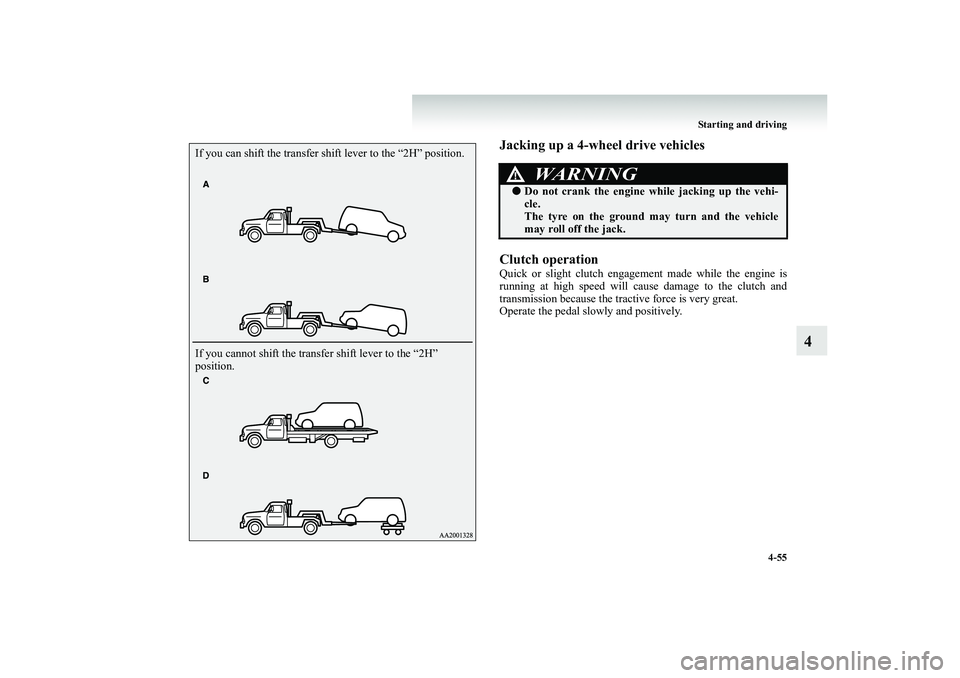
Starting and driving
4-55
4
Jacking up a 4-wheel drive vehicles Clutch operationQuick or slight clutch engagement made while the engine is running at high speed will cause damage to the clutch and transmission because the tractive force is very great. Operate the pedal slowly and positively.
If you can shift the transfer shift lever to the “2H” position. If you cannot shift the transf
er shift lever to the “2H”
position.
WARNING
!●
Do not crank the engine wh
ile jacking up the vehi-
cle. The tyre on the ground
may turn and the vehicle
may roll off the jack.
BK-BK2008E1ENUK.en-uk-Section7.fm Page
55 Wednesday, January 9, 2008 4:36 PM
Page 259 of 538
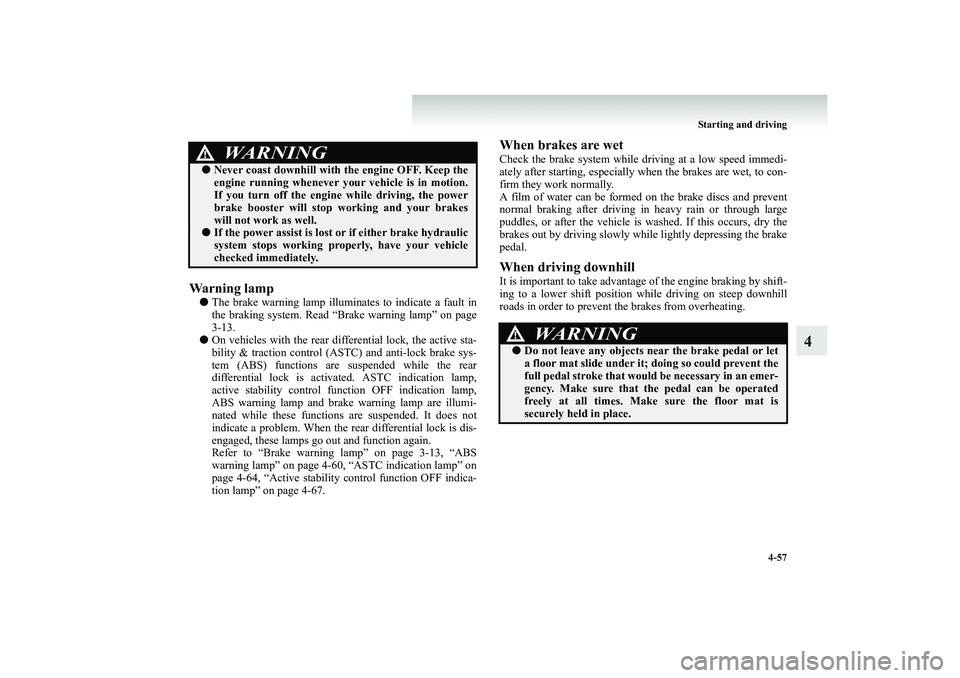
Starting and driving
4-57
4
Wa r n i n g l a m p●
The brake warning lamp illuminates to indicate a fault in the braking system. Read “Brake warning lamp” on page 3-13.
●
On vehicles with the rear di
fferential lock, the active sta-
bility & traction control (AST
C) and anti-lock brake sys-
tem (ABS) functions are
suspended while the rear
differential lock is activat
ed. ASTC indication lamp,
active stability control function OFF indication lamp, ABS warning lamp and brake warning lamp are illumi- nated while these functions are suspended. It does notindicate a problem. When the re
ar differential lock is dis-
engaged, these lamps go out and function again. Refer to “Brake warning lamp” on page 3-13, “ABSwarning lamp” on page 4-60, “ASTC indication lamp” on page 4-64, “Active stability control function OFF indica- tion lamp” on page 4-67.
When brakes are wetCheck the brake system while dr
iving at a low speed immedi-
ately after starting, especially wh
en the brakes are wet, to con-
firm they work normally. A film of water can be formed
on the brake discs and prevent
normal braking after driving in heavy rain or through largepuddles, or after the vehicle is washed. If this occurs, dry the brakes out by driving slowly while lightly depressing the brake pedal.When driving downhillIt is important to take advantage of the engine braking by shift-ing to a lower shift position while driving on steep downhill roads in order to prevent th
e brakes from overheating.
WARNING
!●
Never coast downhill with
the engine OFF. Keep the
engine running whenever your
vehicle is in motion.
If you turn off the engine
while driving, the power
brake booster will stop
working and your brakes
will not work as well.
●
If the power assist is lost
or if either brake hydraulic
system stops working properly, have your vehicle checked immediately.
WARNING
!●
Do not leave any objects near the brake pedal or let a floor mat slide
under it; doing so could prevent the
full pedal stroke that would be necessary in an emer-gency. Make sure that the pedal can be operated freely at all times. Make sure the floor mat is securely held in place.
BK-BK2008E1ENUK.en-uk-Section7.fm Page
57 Wednesday, January 9, 2008 4:36 PM